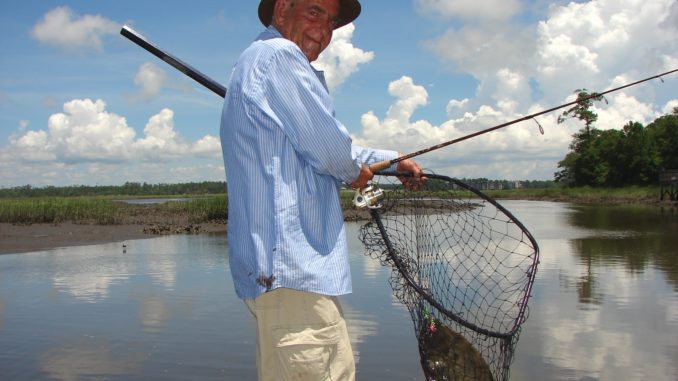
Habitat, tides, baits, nets and tackle; Jimmy Price lays out his flounder-fishing tactics.
Fishermen flock to Capt. Jimmy Price of Southport for advice on catching flounder. He does seminars across the southeast during the offseason, and most are full of anglers willing to travel to learn his methods and laugh at his tales.
Watching fishermen hang on his every word brings to mind the old Kung Fu television show of the late 1960s and early 1970s. Price is the old master, speaking to the aspiring fishermen much as the old master passed pearls of wisdom to a young David Carradine.
If the show had been about fishing, Jimmy Price the master would have said, “Ah yes, Grasshopper, to be able to catch more flounder, you must become the flounder. Once you become the flounder, you will know where, why and how he feeds, and then you can catch him.”
Price’s stellar reputation as a flounder guru is all the introduction he needs. His fishing grounds are around Southport at the mouth of the Cape Fear River, but his tactics work far and wide. He sat down recently to share some of his vast knowledge. Some of his flounder fishing revelations will bring nods of agreement and occasional “Why didn’t I think of that?” moments.
You don’t have to measure the things he said: they’re keepers.
Q: Are you a Southport native or did you move there?
PRICE: “I am from Monroe, but I felt like I wanted to live and raise my family at the coast. We first moved to Surfside Beach, then spent a little time at North Myrtle Beach, and when we got to the Southport/Long Beach area in the late 60s, I just knew it was right. We were visiting Long Beach, and one Sunday afternoon I realized I didn’t want to leave, so I talked to my wife and we didn’t. We settled in at Long Beach (now a part of Oak Island) when it really was a sleepy little place before the development boom. Don’t get me wrong; it’s still nice, but it was really special back then.”
Q: Were you already a dedicated flounder fisherman? If not, when did you develop your fondness for flounder?
PRICE: No, actually I wasn’t. I have always enjoyed fishing and occasionally describe myself as a fishaholic, but I didn’t become a hard-core flounder fisherman until an incident that happened after I moved to Long Beach. I had been flounder fishing a little and liked to catch them, but an experience at Lockwood Folly Inlet one afternoon locked me in for life.
I’m a brick and block mason by trade and was working for a fellow named Floyd Helms and his wife, Bobbie, who were also originally from Monroe. In addition to laying block and brick, Floyd supplied the local piers and several tackle shops with live minnows. We would work until the tide got right to catch minnows and then go catch them.
We would save a dozen or two, and once we delivered the minnows to the piers, the tide would be about right, and we would fish for an hour or so before going back to work. Floyd and Bobbie were serious flounder fishermen and caught a lot. They taught me much of what I know about flounder fishing with live bait.
On this particular day, the bluefish were nailing baits before the flounder could get to them. We had caught one really big mullet that morning, and I dug it out and put it on my rig so they would leave it alone. We joked about what size flounder it would take to eat a mullet that big but agreed the bluefish would probably leave it alone.
On my third cast, something slammed that big mullet and set down on the bottom. It acted just like a big flounder, and I was thinking and hoping it was. Floyd was standing near me and agreed it hit and stopped just like a big flounder. I waited what seemed like a really long time to give it time to turn and swallow that big bait before setting the hook. When I set the hook, that flounder took off and I had to chase it up the beach to keep it from taking all my line.
Finally, it came back to about where I started, and I called to Floyd for some help to land it. We didn’t have a net, so he was going to wade out in the water a little and flip it up on the beach when I got it between him and me. I led the flounder in, and as it came up, we were both speechless at how big it was. It was huge! While we were staring at it so dumbfounded, it opened its mouth, and that big mullet came flying by my head — hook, line and sinker.
Just that quick, that big flounder was gone, but I still see that picture in my mind, and it hooked me on flounder fishing for life. I’ve caught flounder that weighed into the teens, and my memory of that one dwarfs them. I don’t know if they are dreams or nightmares, but I still occasionally dream about that big ol’ flounder, and it’s been over 30 years since that day.”
NCS: What do you look for in a flounder fishing spot?
PRICE: “I’m looking for something that concentrates bait in an area so it will be easy for a flounder to feed. It doesn’t have to be a lot, but flounder aren’t built to chase bait in open water, so I’m looking for something that gives them a place to hide near a good food supply. It can be as simple as an eddy just inside or outside an inlet, a bend in the slope of an oyster or sand bar, the pilings under a dock, the hole under a boat lift, sea walls, jetties, bridge pilings and bulkheads, riprap, sunken wrecks, artificial reefs, behind a sand or oyster bar where a smaller creek drains into a larger one, pockets in the marsh, oyster rocks or at the bottom of a quick drop along a bar into a channel. There are lots of places that have the potential to hold flounder.
Don’t just make a few casts and give up on an area. Work your bait or lure through it at different speeds and at slightly different angles. Sometimes flounder might be holding so close to structure they are laying against or on it. I have had days where a few extra casts a few inches closer or at a different angle caught fish.
When I’m fishing an artificial reef or a larger piece of structure, I start at the edges and work them first. If there aren’t any flounder around the edges, I have to move up into the structure, and with this comes higher potential for getting hung and losing hooks, jigs, rigs and fish. However, if that is where the flounder are on a given day, then that’s where you have to fish for them. When fishing heavy structure, vertically jigging a bucktail and flounder strip doesn’t hang up as often, and that gives you the advantage of more fishing time instead of tying on rigs.
Q: What bait do you prefer?
PRICE: I learned to catch flounder using live baits, but I haven’t used them in a bunch of years. I primarily use a couple of artificial lures now.
Early on, I used mostly mullet minnows. Then I began using mud minnows and peanut pogeys (menhaden) when mullet minnows weren’t available. One thing I learned early on is that a flounder has a big ol’ mouth and he can open it wide. It doesn’t look like that would be a big mouth, but you have to see it wide open to appreciate it.
Bigger baits catch bigger fish, and that big flounder I lost hit a mullet most fishermen would use for a king mackerel bait. I would probably rank 4- to 6-inch pogeys as my favorite live baits for flounder, followed by large finger mullet and mud minnows.
I fished live baits on Carolina rigs I made out of 30-pound Shur Strike mono and used 1/2- to 1 1/2-ounce egg sinkers depending on the depth and current. I began with 20 inches of line and, after tying on the swivel and hook, the leader was about 18 inches. Any longer allows your bait to swim up off the bottom and out of a flounder’s view. The swivel is rated 40 pounds, and the hook is an Eagle Claw 042 or L042 in size No. 4.
I’ve been fishing artificials for flounder for a bunch of years now and believe they are easier to catch on artificials. My favorites are a white bucktail with a white trailer, and Shrimposter lures.
I use a white 5/8-ounce bucktail inside the inlets unless I’m in really deep water or a strong current. I use a 1- to 1 1/2-ounce bucktail in the ocean or really deep water and high current situations. I add a white, 5-inch Pappy’s Baits flounder strip to the bucktail by hooking it about a half-inch in on the wide end.
The secret to fishing the bucktail is to jig it vertically about a foot off the bottom. I may cast it out 5 to 10 feet, but not far. Most of the time, I anchor over the structure I want to fish and drop it right beside the boat. I move around the boat until I zero in on the hot spot.
“I use the Shrimposter to cover a little more bottom. It has a 3/8-ounce head, which has antenna just like a shrimp and looks very natural. I cast it upcurrent and creep it back in, occasionally jigging it up off the bottom. This helps flounder spot it and close in on it. Most strikes will come as it is falling or just after it lands. With the Shrimposter, I can cover more area, and it is soft enough to fold into a flounder’s mouth as soon as it grabs it, and you can set the hook without waiting.
Q: I understand you have some excellent advice for fishermen trying to catch bait using a cast net. Would you care to share it?
PRICE: Sure I’ll share it. It’s just common sense, and I’ll bet some fishermen have seen this and not realized what was happening. I learned this casting the net for mullet minnows many years ago, but it’s true for anything you try to catch in cast nets.
It is very hard to catch bait while it is swimming towards you. Mullet minnows, and just about every other baitfish, are constantly being chased by something that wants to eat them so they are very wary. Most have good eyes, too, and if you throw the cast net while they are swimming toward you and looking at you, they will see it and scatter while it is in the air so you only catch a few or none at all.
“A big key to cast netting bait quickly and easily is to let it swim by and throw the cast net from behind. They don’t have eyes in the back of their heads, so they won’t see the net coming and scatter. This is very simple, but it makes a lot of difference, and if bait is scarce, it could be the difference between having live bait and not having it.
Q: You obviously prefer using artificial baits to catch flounder. Can you tell us why?
PRICE: The biggest reason is you can set the hook as soon as you feel the strike when fishing with artificial baits, and you have to wait with live baits. A flounder has to turn a live bait so it is head first to be able to swallow it. If he doesn’t, the fins will hang in his throat, and he can’t swallow it. This takes time. With smaller baits, it might only be a 5- or 10-count, but with larger baits, you might want to wait a minute or more to be sure the flounder has turned the bait and has it deep enough in his mouth to set the hook.
“Another reason is flounder are more aggressive with artificial baits. I don’t know why, but when they grab an artificial bait, they grab it harder, grip it firmer and hold it deeper in their mouths. This allows you to set the hook as soon as you feel the strike.”
Q: Is there a better time and tide for catching flounder?
PRICE: I don’t know that there is a best time of day to catch flounder. Certainly, during the heat of the summer, fishermen will be more comfortable early and late in the day, but the flounder will often bite any time the tide is moving. They usually shut down during the slack periods when the tide is changing direction.
It has been a while since I used live baits for flounder, but I generally liked the time from the middle of the rising tide until the middle of the falling tide. This is when the tide is high enough the baitfish can get into the flooded marsh grass on the flats and in creeks. Flounder lay in wait and ambush them going into the grass and again when the falling tide forces the bait out.
This is a good time to fish shallow for flounder. They will move right up to the edge of the grass on flats and around creek mouths. I’m sure you’ve seen the bait explosions right next to the grass. Flounder aren’t the only fish that do this. Red drum and trout also feed on baitfish moving into or along the grass while the tide is rising and then wait in ambush when the bait has to come back out on the falling tide.”
You create your own excitement when fishing with bucktails or Shrimposters, and you might catch flounder at just about any stage of the tide. When you jig either of them, it gets a flounder’s attention and gets it ready to strike. The excitement of watching the bait slowly get closer might also be one of the reasons flounder strike artificials so much more aggressively.
Q: What is your favorite flounder-fishing outfit?
PRICE: “I like to fish a 7-foot, Star Plasma spinning rod, rated 8 to 17 pounds. I use a Shimano Stradic reel in the 4000 size, which balances well on this rod. I still use mono line as it hasn’t let me down and I’m comfortable with it. I hear a lot about braided lines, but I’ve just never felt the need to try them. I like Silver Thread AN 40 or Suffix line in 8-pound test for inside waters and 14-pound test for fishing the artificial reefs in the ocean. I don’t use a leader either. I tie the bucktail or Shrimposter directly to the end of the line using an improved clinch knot.”
Q: Do you have any other quick and easy tips you would like to share?
PRICE: Yes, three things come to mind. The structure on the nearshore artificial reefs extends up from the bottom for several feet. The reason I use heavier line here is to be able to put extra pressure on the fish right after hooking it to get it off the bottom and above the structure while it is still surprised from being hooked. This keeps it from swimming into a hole on the reef and breaking off. I think this is a crucial part of catching flounder on the artificial reefs.
My second point is scent. Some artificial lures have it and some you have to add it. Pappy’s flounder strips come with scent already added. I like to use a little Jack’s Juice spray scent on my Shrimposters and other soft baits when I use them. However, I don’t hold the bait up and spray it. I put several baits in a Zip Lock bag and give them two good squirts in the bag. This way, there isn’t much loss of the scent, and they stay in the scent until I get one out to use it. The scent also lasts longer on the bait and a can will last a season — maybe two.
I also want to make a point about netting fish, not just flounder, but any fish. You should always net fish head first. If you try to net the fish from behind or any other direction and touch it, it will take off in a big hurry and may pull the hook. Fish don’t have reverse, so if you net them head first, and if one spooks, it will swim into the net, not out of it. Concentrate on this and you’ll have less netting mishaps with all fish.”
NOTE: Capt Jimmy Price is no longer guiding, but he works most afternoons and weekends at his son’s store, Wildlife Bait and Tackle (910-457-9903) in Southport.

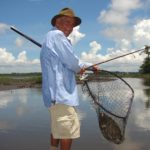
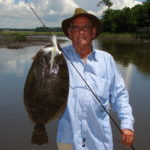
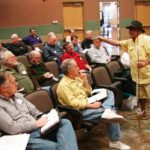
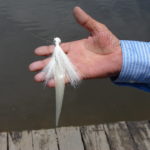
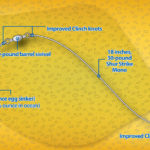



Be the first to comment